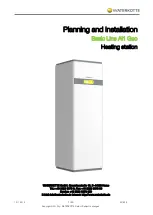
11. Hold the Arc Start Switch down until an arc is
established. The arc will start at a low current
value that is equal to 25% of the preset current
established in Step 4. It will remain at this current
as long as the Arc Start Switch is closed. Release
the Arc Start Switch. At this point, the Square
Wave TIG 275 will quickly ramp up to the preset
maximum welding current, (0.5 seconds upslope
time) and the weld will continue indefinitely. Press
the Arc Start Switch a second time to initiate the
Downslope time. The current will go down to a
crater fill current that is equal to 25% of the weld-
ing current. Release the Arc Start Switch to stop
the arc and start the Post flow timer. After the Post
flow time has expired, the gas and optional water
valves will close. To make another weld, repeat
steps 10 and 11.
HAND AND FOOT AMPTROL OPERATION
Both the Hand and Foot Amptrol work in a similar man-
ner. They are meant to be used for remote current con-
trol. The TIG 2-Step mode must be selected when
using an Amptrol for remote current control.
For simplicity, the following explanation will refer only to
"Amptrols", meaning both Foot and Hand models. The
term "minimum" refers to a Foot pedal in the "up" posi-
tion, as it would be with no foot pressure, or a Hand
Amptrol in the relaxed position, with no thumb pres-
sure. "Maximum" refers to a fully depressed Foot
Amptrol, or a fully extended Hand Amptrol.
The Amptrol is capable of controlling the output current
from 5 amps to the preset current on the output control
knob. For example, if the preset is at 200 amps, the
Amptrol, when depressed just past its minimum posi-
tion, will cause the Square Wave TIG 275 to weld at 5
amps. At the Amptrol's maximum position, the output
will be near 200 amps.
It is important to note that, for many applications, the
tungsten will not start an arc at only 5 amps. (Refer to
the TIG Welding Guidelines for recommended tungsten
currents.) To start an arc reliably, it is important to
depress the Amptrol far enough so that the machine
output current is near the tungsten operating range. In
the example above, a 3/32" tungsten may be used on
DC- to weld near 200 amps. To start the weld, the
operator may have to depress the Amptrol approxi-
mately 1/4 of the way down, or to nearly 50 amps, in
order to start the arc. Merely depressing the Amptrol to
its 5 amp minimum position will not start the arc.
ADVANCED TIG WELDING FEATURES
AC WAVE BALANCE AND AUTO BALANCE™
The AC Wave Balance feature is unique to the Square
Wave TIG 275. It is active only in AC TIG mode. It con-
trols the amount of positive and negative current in the
AC output.
The Square Wave TIG 275 allows the operator to
select Auto Balance™. This selection provides auto-
matic adjustment of the AC Wave Balance; it is suitable
for most welding conditions. Auto Balance™ gives the
ideal amount of cleaning and penetration, based on the
welding current output.
Manual adjustment of the AC Wave Balance is also
possible. Manual Balance settings vary from 0 (maxi-
mum cleaning) to 10 (maximum penetration). A setting
of 3 yields a balanced output (equal amounts of clean-
ing and penetration). Use the following as a guide
when setting the Balance manually:
BALANCED (3): The amounts of positive and negative
are the same.
CLEANING (0 to 2): Provides more positive current
than negative current. Since the positive cur-
rent produces the "cleaning" or oxide removal
on aluminum, this setting is used for welding on
heavily oxidized aluminum.
PENETRATION (4 to 10): Provides more negative cur-
rent than positive. The arc plasma will be more
concentrated and more easily directed to where
the heat is needed. Higher penetration settings
allow a given size of tungsten to carry more cur-
rent.
CAUTION: Use only the amount of cleaning required
because the greater amount of positive current will
heat the tungsten more and possibly cause it to melt or
"spit". Also, the arc is usually more flared and less sta-
ble with more cleaning current.
In general, use just enough "cleaning" to remove
oxides and to give good wetting of the puddle.
OPERATION
B-8
B-8
SQUARE WAVE TIG 275
Retur
n to Section TOC
Retur
n to Section TOC
Retur
n to Section TOC
Retur
n to Section TOC
Retur
n to Master TOC
Retur
n to Master TOC
Retur
n to Master TOC
Retur
n to Master TOC
















































